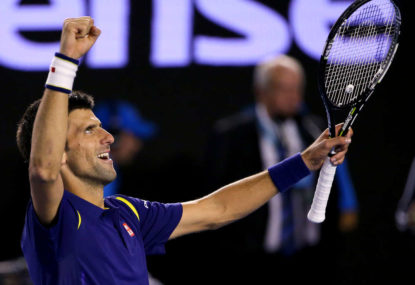Angelique Kerber’s stunning upset over world number one Serena Williams was a timely reminder that even the implausible can manifest into reality on the tennis court.
Even so, it was a little far-fetched to believe the Australian Open men’s final could replicate that historic and utterly gripping women’s decider.
More Australian Open final:
» Men’s final scorecard
» Novak joins the legends
» Fith time unlucky for Murray
Thus, it would appear, miracles do not happen on consecutive nights. Novak Djokovic, who is playing tennis about as well as humanly possible, defeated Andy Murray in straight sets in a predictable victory.
Most wise pundits expected Djokovic to win fairly comfortably – in four sets was the popular pick – but there was belief Murray could at least mount a serious challenge. After all, the renowned rivalry over the years has generally produced long close matches punctuated by relentless slugging from the baseline.
Truth be told, it was a disappointing match, an anti-climax, with Murray never really in it after a sluggish start where he humiliatingly lost the opening set 6-1.
This was entirely different to the early stages of Djokovic’s semi-final victory over Roger Federer where he mastered the sport to almost perfection. In the first set against Murray, the Serbian played controlled but hardly spectacular tennis. He didn’t need to shift gears because Murray was gifting him so many cheap points with an array of miscues.
Strangely, it was a subdued Murray who looked like he was ambling around the court in a trance. Perhaps off-court dramas combined with a gruelling semi-final had taken its toll on Murray. Still, it was particularly jarring to see the normally highly animated Murray look so flat.
There was a genuine prospect that the men’s final would be shorter than the women’s decider after Djokovic went up an early break in the second set. But flipping the script, the world number two fought back with trademark pluck over the next two sets but Djokovic was better in the big moments to win a match he never looked like losing.
Right now, Djokovic – who claimed his 11th major overall – is at the height of his prowess and at the juncture of his career where mind and body are in perfect sync.
The victory was Djokovic’s sixth Australian Open title, the most in the open era, and his 11th major overall to tie him with Swedish legend Bjorn Borg and Australian champion Rod Laver.
Roger Federer’s record of 17 majors is surely now in his sights.
It is hard to conjure more superlatives for Djokovic. If it wasn’t for Stan Wawrinka transforming into a superhero at Roland Garros last year, Djokovic would have now won five consecutive slams. Read that sentence again if you need to.
The gulf in men’s tennis from number one to the rest has not been this vast since Federer was clearly ahead of the pack in the mid-2000s.
Despite being the best player in the world for the bulk of the past five years, it has only been within this last astonishing 12 months that Djokovic is now being perceived in the same rarefied realm as Federer and Nadal.
He’ll need to win the French Open, that elusive major he’s yet to claim, to silence some of the few remaining cynics. If Djokovic can indeed win the calendar grand slam, a feat no men’s player has achieved since Laver in 1969, then he’ll be legitimately challenging Federer’s assumed “greatest ever” mantle.
If that actually happens, Djokovic will end the year at 14 majors – tied second overall with Nadal and Pete Sampras – and he’ll be within striking distance of Federer’s record. It’s remarkable that Djokovic is swiftly closing in on Federer’s landmark because you always felt slams would be shared around during this era of the “big four”.
There are several notable reasons why Djokovic has propelled past his adversaries. Federer’s advancing age means he’s probably 80 per cent of the player he was in his peak of the mid-2000s. Nadal’s body is breaking down after a decade of punishment due to his high-octane game. Even Murray’s body has been battered with back and other ailments in recent years. He looks like he could break down at any moment.
Meanwhile, Djokovic looks physically stronger and mentally sharper than ever. He’s the same age as Murray, and only a year younger than Nadal, but Djokovic seems in much better shape and you feel he can extend his prime – in a similar vein to Federer – longer than those two.
Transforming his body in a determined bid for more flexibility, which sees him now stalking the court like a gymnast, has propelled his game to new heights. It is a revealing insight into Djokovic’s resolve and shows the lengths he’ll go to maximise his talents in an effort to separate from the pack.
Balls that appear surely out of reach just aren’t with Djokovic because of his super human ability to contort his body. Watching his uncanny array of slides and lunges simply defies physics. His feet are twisted in angles that appear unnatural, while his knees buckle and hips swivel.
It appears to be a recipe for a disaster, but Djokovic’s indefatigable training has fine-tuned his body into a sinewy powerhouse.
Once upon a time, Djokovic was perceived as temperamental and mentally fragile. Those days seem like a distant memory now. It was a notable juxtaposition seeing a composed Djokovic compared with Murray who looked likely to implode at any minute.
It is hard to see Djokovic being stopped this year. There will be the occasional loss of course, but it is doubtful anyone can survive this tour de force over five sets.
Djokovic is chasing the record books; he’s striving for immortality this year. Right now, it would be foolish to bet against him.





























































































